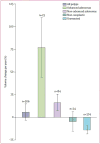The Natural History of Colorectal Polyps: Overview of Predictive Static and Dynamic Features
- PMID: 30115435
- PMCID: PMC6100796
- DOI: 10.1016/j.gtc.2018.04.004
The Natural History of Colorectal Polyps: Overview of Predictive Static and Dynamic Features
Abstract
For decades, colorectal screening strategies have been largely driven by static features, particularly polyp size. Although cross-sectional features of polyp size, morphology, and location are important determinants of clinical relevance before histology, they lack any dynamic information on polyp growth rates. Computed tomography colonography allows for in vivo surveillance of colorectal polyps, providing volumetric growth rates that are providing new insights into tumorigenesis. In this article, existing cross-sectional and longitudinal data on colorectal polyps are reviewed, with an emphasis on how these features may affect clinical relevance and patient management.
Keywords: CT colonography; Colorectal cancer; Colorectal polyps; Optical colonoscopy; Virtual colonoscopy.
Copyright © 2018 Elsevier Inc. All rights reserved.
Figures











References
-
- Pickhardt PJ, Hain KS, Kim DH, Hassan C. Low rates of cancer or high-grade dysplasia in colorectal polyps collected from computed tomography colonography screening. Clin Gastroenterol Hepatol. 2010;8:610–5. - PubMed
-
- Pickhardt PJ, Kim DH. Colorectal cancer screening with CT colonography: key concepts regarding polyp prevalence, size, histology, morphology, and natural history. American Journal of Roentgenology. 2009;193:40–6. - PubMed
-
- Ponugoti PL, Cummings OW, Rex DK. Risk of cancer in small and diminutive colorectal polyps. Dig Liver Dis. 2017;49:34–7. - PubMed
-
- Hassan C, Pickhardt PJ, Kim DH, et al. Systematic review: distribution of advanced neoplasia according to polyp size at screening colonoscopy. Aliment Pharmacol Ther. 2010;31:210–7. - PubMed
Publication types
MeSH terms
Grants and funding
LinkOut - more resources
Full Text Sources
Other Literature Sources
Medical

